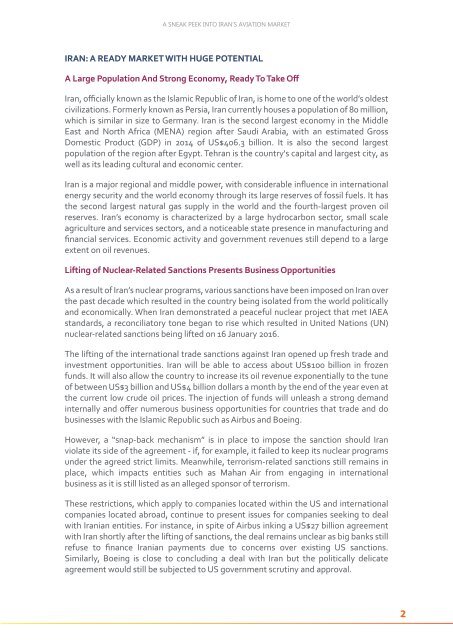You also want an ePaper? Increase the reach of your titles
YUMPU automatically turns print PDFs into web optimized ePapers that Google loves.
A SNEAK PEEK INTO IRAN’S AVIATION MARKET<br />
IRAN: A READY MARKET WITH HUGE POTENTIAL<br />
A Large Population And Strong Economy, Ready To Take Off<br />
Iran, officially known as the Islamic Republic of Iran, is home to one of the world’s oldest<br />
civilizations. Formerly known as Persia, Iran currently houses a population of 80 million,<br />
which is similar in size to Germany. Iran is the second largest economy in the Middle<br />
East and North Africa (MENA) region after Saudi Arabia, with an estimated Gross<br />
Domestic Product (GDP) in 2014 of US$406.3 billion. It is also the second largest<br />
population of the region after Egypt. Tehran is the country's capital and largest city, as<br />
well as its leading cultural and economic center.<br />
Iran is a major regional and middle power, with considerable influence in international<br />
energy security and the world economy through its large reserves of fossil fuels. It has<br />
the second largest natural gas supply in the world and the fourth-largest proven oil<br />
reserves. Iran’s economy is characterized by a large hydrocarbon sector, small scale<br />
agriculture and services sectors, and a noticeable state presence in manufacturing and<br />
financial services. Economic activity and government revenues still depend to a large<br />
extent on oil revenues.<br />
Lifting of Nuclear-Related Sanctions Presents Business Opportunities<br />
As a result of Iran’s nuclear programs, various sanctions have been imposed on Iran over<br />
the past decade which resulted in the country being isolated from the world politically<br />
and economically. When Iran demonstrated a peaceful nuclear project that met IAEA<br />
standards, a reconciliatory tone began to rise which resulted in United Nations (UN)<br />
nuclear-related sanctions being lifted on 16 January 2016.<br />
The lifting of the international trade sanctions against Iran opened up fresh trade and<br />
investment opportunities. Iran will be able to access about US$100 billion in frozen<br />
funds. It will also allow the country to increase its oil revenue exponentially to the tune<br />
of between US$3 billion and US$4 billion dollars a month by the end of the year even at<br />
the current low crude oil prices. The injection of funds will unleash a strong demand<br />
internally and offer numerous business opportunities for countries that trade and do<br />
businesses with the Islamic Republic such as Airbus and Boeing.<br />
However, a “snap-back mechanism” is in place to impose the sanction should Iran<br />
violate its side of the agreement - if, for example, it failed to keep its nuclear programs<br />
under the agreed strict limits. Meanwhile, terrorism-related sanctions still remains in<br />
place, which impacts entities such as Mahan Air from engaging in international<br />
business as it is still listed as an alleged sponsor of terrorism.<br />
These restrictions, which apply to companies located within the US and international<br />
companies located abroad, continue to present issues for companies seeking to deal<br />
with Iranian entities. For instance, in spite of Airbus inking a US$27 billion agreement<br />
with Iran shortly after the lifting of sanctions, the deal remains unclear as big banks still<br />
refuse to finance Iranian payments due to concerns over existing US sanctions.<br />
Similarly, Boeing is close to concluding a deal with Iran but the politically delicate<br />
agreement would still be subjected to US government scrutiny and approval.<br />
2


